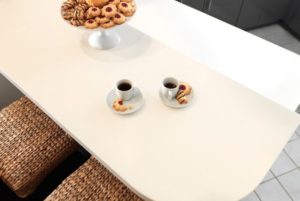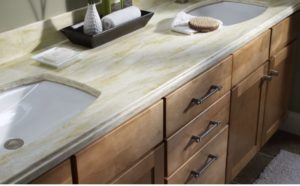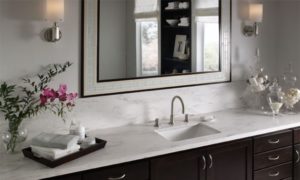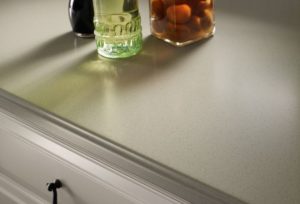 A solid surface countertop is one of the most functional and durable surfaces out there. It’s versatile and easy to maintain and comes in a wide variety of colors and patterns. Whatever brand you end up going with, solid surface countertops are a great selection for your kitchen or bathroom.
A solid surface countertop is one of the most functional and durable surfaces out there. It’s versatile and easy to maintain and comes in a wide variety of colors and patterns. Whatever brand you end up going with, solid surface countertops are a great selection for your kitchen or bathroom.
As there are numerous brands that make solid surfaces, the manufacturer and exact composition of your solid surface countertop can vary. Generally, it’s an acrylic, epoxide or polyester resin, which is then mixed with various pigments to produce a wide variety of colors. It can either be cut into sheets or shapes or injected into a mold to produce a more decorative design, complete with any decorative touches right from the initial creation.
Polyester-based solid surfaces are generally cheaper, and will provide a higher-gloss finish. They’re less likely to have the perfect seam you’re hoping for, though, so many people chose the newer acrylic-based solid surfaces. They cost a little more, but are less likely to chip and crack, and are easier to join together in a seamless fashion. No matter which type of resin your brand uses, it will likely arrive at your builder in a solid sheet.
Your contractor will take these sheets of solid surface, in your chosen color and style, and cut them to match the size and shape of your countertops. Then, they will bind them together using a color-matched epoxy. The pieces will be clamped close together, and then left to dry. The contractor will then sand off the excess epoxy and polish the area. This creates the illusion of the countertop being one consistent piece rather than multiple pieces joined together; because solid surfaces have the same color and patterns all the way through, they can be sanded down to match without losing their aesthetic value.
It’s really a very simple process when handled by experts who know what they’re doing. From formation to installation, a solid surface countertop is specially designed to meet all your countertop needs, from aesthetics to health and everything in between. When you get a solid surface countertop, you know you’re getting a durable work surface that will last you a long time without significant upkeep. For many design projects, a solid surface countertop will end up being the way to go.
 Cultured marble is a relatively new material used for countertops and other home renovation purposes—it’s less than 40 years old. A blend of marble and resin, cultured marble is cheaper, easier to care for, more versatile and easier to install than natural marble, making it a very popular choice for people looking for a marble look but without the headaches of dealing with the actual natural material itself.
Cultured marble is a relatively new material used for countertops and other home renovation purposes—it’s less than 40 years old. A blend of marble and resin, cultured marble is cheaper, easier to care for, more versatile and easier to install than natural marble, making it a very popular choice for people looking for a marble look but without the headaches of dealing with the actual natural material itself. The phrase “solid surface” can be a bit confusing when you’re first learning about countertops and their potential materials. After all, aren’t all countertops a solid surface? However, when your contractor or renovator uses the phrase “solid surface countertops”, they’re referring to a specific man-made surface that has brought a significant new option to kitchen and bathroom renovations.
The phrase “solid surface” can be a bit confusing when you’re first learning about countertops and their potential materials. After all, aren’t all countertops a solid surface? However, when your contractor or renovator uses the phrase “solid surface countertops”, they’re referring to a specific man-made surface that has brought a significant new option to kitchen and bathroom renovations. When you opt to install kitchen countertops, there are dozens of different kinds of surfaces to choose from. One of the most popular is a solid surface, like DuPont’s Corian or other similar brands. The man-made surface has several significant pros over more natural countertops like granite or marble, though it comes with its drawbacks as well. Here are some solid surface countertops pros and cons to help you make your decision.
When you opt to install kitchen countertops, there are dozens of different kinds of surfaces to choose from. One of the most popular is a solid surface, like DuPont’s Corian or other similar brands. The man-made surface has several significant pros over more natural countertops like granite or marble, though it comes with its drawbacks as well. Here are some solid surface countertops pros and cons to help you make your decision.



 Copyright © 2025 · Solid Surface · Web design by
Copyright © 2025 · Solid Surface · Web design by